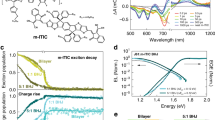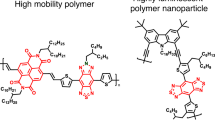Abstract
Some conjugated polymers have luminescence properties that are potentially useful for applications such as light-emitting diodes, whose performance is ultimately limited by the maximum quantum efficiency theoretically attainable for electroluminescence1, 2,. If the lowest-energy excited states are strongly bound excitons (electron–hole pairs in singlet or triplet spin states), this theoretical upper limit is only 25% of the corresponding quantum efficiency for photoluminescence: an electron in the π*-band and a hole (or missing electron) in the π-band can form a triplet with spin multiplicity of three, or a singlet with spin multiplicity of one, but only the singlet will decay radiatively3. But if the electron–hole binding energy is sufficiently weak, the ratio of the maximum quantum efficiencies for electroluminescence and photoluminescence can theoretically approach unity. Here we report a value of ∼50% for the ratio of these efficiencies (electroluminescence:photoluminescence) in polymer light-emitting diodes, attained by blending electron transport materials with the conjugated polymer to improve the injection of electrons. This value significantly exceeds the theoretical limit for strongly bound singlet and triplet excitons, assuming they comprise the lowest-energy excited states. Our results imply that the exciton binding energy is weak, or that singlet bound states are formed with higher probability than triplets.
This is a preview of subscription content, access via your institution
Access options
Subscribe to this journal
Receive 51 print issues and online access
$199.00 per year
only $3.90 per issue
Buy this article
- Purchase on Springer Link
- Instant access to full article PDF
Prices may be subject to local taxes which are calculated during checkout



Similar content being viewed by others
References
Burroughes, J. H. et al. Light-emitting diodes based on conjugated polymers. Nature 347, 539–541 (1990).
Braun, D. & Heeger, A. J. Visible light emission from semiconducting polymer diodes. Appl. Phys. Lett. 58, 1982–1984 (1991).
Bradley, D. D. C. Conjugated polymer electroluminescence. Synth. Met. 54, 401–415 (1993).
Parker, I. D. Carrier tunneling and device characteristics in polymer light-emitting diodes. J. Appl. Phys. 75, 1656–1666 (1994).
Campbell, I. H., Hagler, T. W., Smith, D. L. & Ferraris, J. P. Direct measurement of conjugated polymer electronic excitation energies using metal/polymer/metal structures. Phys. Rev. Lett. 76, 1900–1903 (1996).
Richter, M. M., Fan, F., Klavetter, F., Heeger, A. J. & Bard, A. Electrochemistry and electrogenerated chemiluminescence of films of the conjugated polymer 4-methoxy-(2-ethylhexyloxy)-2,5-polyphenylenevinylene. Chem. Phys. Lett. 226, 115–120 (1994).
Brom, P., Birgersson, J., Johansson, N., Logdland, M. & Salaneck, W. R. Calcium electrodes in polymer LEDs. Synth. Met. 74, 179–181 (1995).
Yang, Y., Westerweele, E., Zhang, C., Smith, P. & Heeger, A. J. Enhanced performance of polymer light-emitting diodes using high-surface area polyaniline network electrodes. J. Appl. Phys. 77, 694–698 (1995).
Gao, J., Heeger, A. J., Lee, J. Y. & Kim, C. Y. Soluble polypyrrole as the transparent anode in polymer light-emitting diodes. Synth. Met. 82, 221–223 (1996).
Cao, Y., Yu, G., Zhang, C., Menon, R. & Heeger, A. J. Polymer light-emitting diodes with polyethylene dioxythiophene-polystyrene sulfonate as the transparent anode. Synth. Met. 87, 171–174 (1997).
Kuhn, H. Classical aspects of energy transfer in molecular systems. J. Chem. Phys. 53, 101–108 (1970).
Greenham, N. C. Understanding the limits to performance in electronic devices based on PPV. Bull. Am. Phys. Soc. 43 (1), 14 (1998).
Blom, P. W. M., de Jong, M. J. M. & Vleggaar, J. J. M. Electron and hole transport in poly(p-phenylene vinylene). Appl. Phys. Lett. 68, 3308–3310 (1996).
Blom, P. W. M., de Jong, M. J. M. & Munster, M. G. Electric-field and temperature dependence of the hole mobility in poly(p-phenylene vinylene). Phys. Rev. B 55, 656–659 (1997).
Blom, P. W. M., de Jong, M. J. M. & Breedijk, S. Temperature dependence electron-hole recombination in polymer light-emitting diodes. Appl. Phys. Lett. 71, 930–932 (1997).
Greenham, N. C. et al. Measurement of absolute photoluminescence quantum efficiencies in conjugated polymer. Chem. Phys. Lett. 241, 89–96 (1995).
Schmidt, A., Anderson, M. L. & Armstrong, N. R. Electronic states of vapor deposited electron and hole transport agents and luminescent materials for light-emitting diodes. J. Appl. Phys. 78, 5619–5625 (1995).
Kersting, R. et al. Ultrafast field-induced dissociation of excitons in conjugated polymers. Phys. Rev. Lett. 73, 1440–1443 (1994).
Moses, D. et al. Mechanism of carrier generation in poly(phenylene vinylene): Transient photoconductivity and photoluminescence at high fields. Phys. Rev. B 54, 4748–4754 (1996).
Greenham, N. C., Friend, R. H. & Bradley, D. D. C. Angular dependence of the emission from a conjugated polymer light-emitting diode: implications for efficiency calculations. Adv. Mater. 6, 491–494 (1994).
Lemmer, U. et al. Electroluminescence from poly(phenylene vinylene) in a planar metal-polymer-metal structure. Appl. Phys. Lett. 68, 3007–3009 (1996).
Sariciftci, N. S. (ed.) Primary Photoexcitations in Conjugated Polymers: Molecular Excitons vs Semiconductor Band Model (World Scientific, Singapore, (1997)).
Smilowitz, L. & Heeger, A. J. Photoinduced absorption from triplet excitations in poly(2-methoxy,5-(2′-ethylhexyloxy)-p-phenylene vinylene) oriented by gel processing in polyethylene. Synth. Met. 48, 193–196 (1992).
Hide, F. et al. Semiconducting polymers: a new class of solid state laser materials. Science 273, 1833–1836 (1996).
Acknowledgements
Research at UNIAX was partially supported by the Office of Naval Research.
Author information
Authors and Affiliations
Rights and permissions
About this article
Cite this article
Cao, Y., Parker, I., Yu, G. et al. Improved quantum efficiency for electroluminescence in semiconducting polymers. Nature 397, 414–417 (1999). https://doi.org/10.1038/17087
Received:
Accepted:
Issue Date:
DOI: https://doi.org/10.1038/17087
This article is cited by
-
Facile conversion of water to functional molecules and cross-linked polymeric films with efficient clusteroluminescence
Nature Communications (2023)
-
Comparison of simulated and experimental data for optimized OLEDs
Optical and Quantum Electronics (2022)
-
Electronic structure analysis of nano-lens arrays
Journal of Materials Science (2021)
-
Molecular-level insights on the reactive facet of carbon nitride single crystals photocatalysing overall water splitting
Nature Catalysis (2020)
-
Implementation of an E-Payment Security Evaluation System Based on Quantum Blind Computing
International Journal of Theoretical Physics (2020)
Comments
By submitting a comment you agree to abide by our Terms and Community Guidelines. If you find something abusive or that does not comply with our terms or guidelines please flag it as inappropriate.



